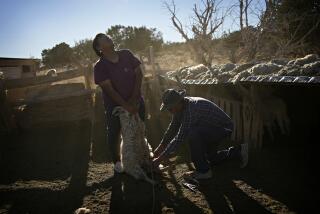Buffalo Reclaiming Their Historic Home on the Range
- Share via
NEW ROCKFORD, N.D. — More than a century after they were hunted to the brink of extinction, buffalo are back.
They’ve returned to ranches and reservations across the Great Plains, generating hundreds of millions of dollars in business.
Nowhere is that more evident than in this small town, home to the North American Bison Cooperative. The processing plant supplies 60% of buffalo meat in the United States in an industry where demand outpaces supply.
“It’s growing as fast as the buffalo will allow,” says Dennis Sexhus, chief operating officer of the co-op, which plans a second plant within two years.
More than 260 U.S. and Canadian ranchers--ranging from mom-and-pop operators to media magnate Ted Turner, owner of the nation’s largest herd--are co-op members. The buffalo are slaughtered here and sold to restaurants, grocers and meat distributors across the United States. About 20% is shipped to Europe.
While some experts say this buffalo boon could help revive the troubled farm economy in the Plains, Roger Johnson, state agriculture commissioner, is cautious.
“The industry is a tiny niche that fits for some producers,” he says. “It’s another way of making a living out here.”
With inch-thick hides and dense piles of fur coating 2,000-pound bodies, the buffalo can outrun a horse, outjump cattle and withstand the Plains’ brutal winters, where windchills can dip to 60 below.
“They’re more acclimated than any other animal you can put here,” said Sam Albrecht, director of the National Bison Assn. based in Denver. He estimates the buffalo industry is worth $500 million a year.
So hardy are these animals that during the blizzards and storms of 1996-1997, North Dakota lost 123,000 head of cattle, but, Johnson says, “I don’t think we buried a single buffalo.”
Buffalo is a delicacy that has found its way onto tables everywhere from trendy New York restaurants to beer-and-burger joints in the West. It’s appealing because it is grown without hormones and is leaner and lower in fat and cholesterol than beef. It also is two to three times more expensive.
Despite its popularity, it is too small a market to be considered a competitor to beef. Only about 20,000 buffalo are slaughtered a year, compared with 135,000 beef cattle a day.
But buffalo provide more than meat. Parts of the animals are sold for jewelry, artwork, shoes and handbags, often through Western mail catalogs.
“My kids went to college on the heads and hides and bones,” says Ken Throlson, the North American co-op’s president, who has a herd of more than 700 buffalo here.
“There’s nothing I could grow that would return for me the way the buffalo does,” adds Throlson, a veterinarian who began raising buffalo as a hobby before turning it into a livelihood.
Buffalo, which once provided Indians with everything from tools to tepees and shoes to food, also are back on tribal lands.
In the last four years, tribal herds have grown from 1,500 to more than 10,000 on a half-million acres, mostly in the Plains, says Mark Heckert, director of the Intertribal Bison Cooperative in Rapid City, S.D.
The cooperative, which represents 45 tribes, wants to return buffalo to the daily life of Indians, using the animals for food, ceremonies and tourist attractions.
“The casino will come and go,” Heckert says. “The tribes will be there. They have to sustain something in perpetuity. That’s what the buffalo will do.”
More to Read
Sign up for Essential California
The most important California stories and recommendations in your inbox every morning.
You may occasionally receive promotional content from the Los Angeles Times.













